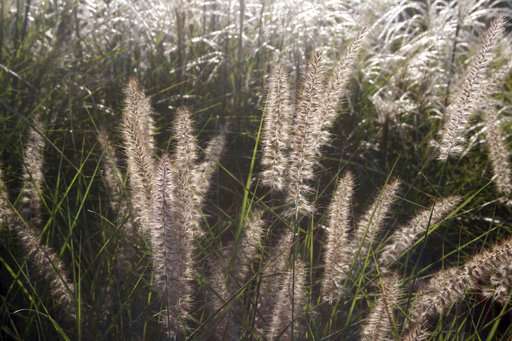To protect pollinators, go easy on the fall garden cleanup

Time to rake up the yard, deadhead the perennials and till the vegetable garden? Not so fast.
Popular opinion is swinging toward letting things stay just as they are through winter—decayed and drab but serviceable.
Displaying a messy yard may not win any good-neighbor awards, but entomologists say our vital but dwindling insect pollinator populations would be much better off.
"People are increasingly recognizing the value of having good habitat throughout the seasons," said Deborah Landau, a conservation ecologist with the Maryland/D.C. chapter of the Nature Conservancy.
"Sometimes it's hard to make the connection with the insects you see in the garden in the warm months with the dried litter remaining when it cools, but it's important to keep that structure going through winter," Landau said.
Such structure includes standing stalks of dead plants, especially under flower heads, where butterflies seek shelter. It also includes layers of leaf litter that collect to protect larvae, egg masses, hibernating wild bees, dormant spiders and many other beneficial insects.
"Cavity-nesting bees may have made their home in old canes of raspberries and perhaps some ornamental grasses," said Rebecca Finneran, a consumer horticulture educator with Michigan State University Extension.
"These two items usually are not cleaned up until spring anyway, but they also can be preserved by placing them (upright) in an out-of-the-way location such as behind a compost pile, and the larvae will still hatch.
"The main thing is not to destroy the stems," she said.
Pollinator cautions aside, which autumn landscape chores are most important, and which can safely be left until spring?

Build a priority list. Consider:
- Giving your yard at least one last soaking before reeling up the hoses for winter.
- Planting a cover crop and adding new perennials including bulbs, trees and shrubs at a time when fall moisture can help establish their root systems.
- Removing ailing plants to help with disease control during the upcoming planting season.
- Not disturbing bare soil where many wild bee species, including bumblebees, overwinter in small nests. "Many of our ground-nesting species will not be bothered by a general cleanup, but I will tell you that I had bumblebees working my late-blooming coral bells up until frost," Finneran said.
- Delaying tilling. Put nature to work through winter with earthworms.
- Postponing pulling up your summer annuals and chrysanthemums until spring. They'll trap whatever leaves blow by, creating their own enriching mulch while shielding insects.
"What I tell people concerned about how things might look is just clean up in the front yard and let things go in the back," Landau said. "Remove any layers of material from the garden that might have fungus in it. But if it's simply dead, leave it alone."
Brush piles are great wintertime protection for a variety of wildlife species, and the more you can leave them untouched, the better, she said. "Otherwise, you might unearth or squash insect larvae.
"Leave at least a little corner of the property intact," Landau said. "Any little bit will help since you have insects living in your garden the year-round."
© 2018 The Associated Press. All rights reserved.





















